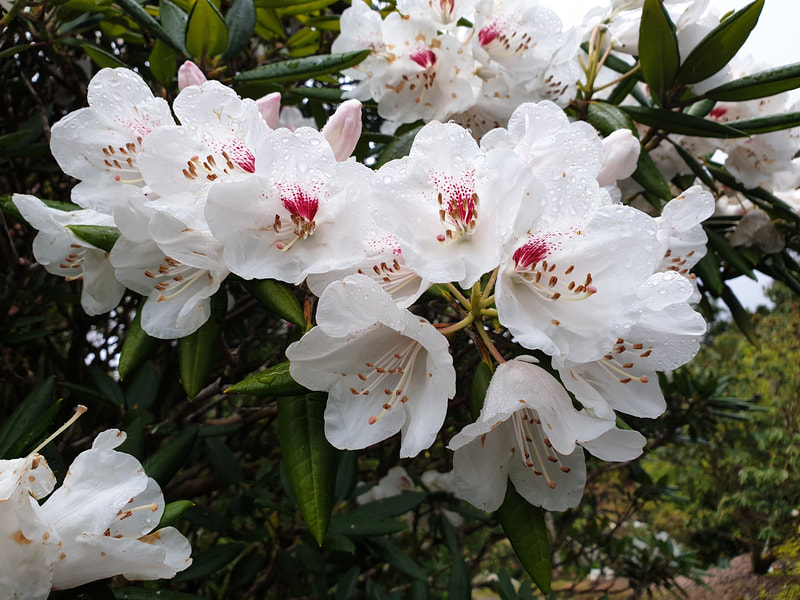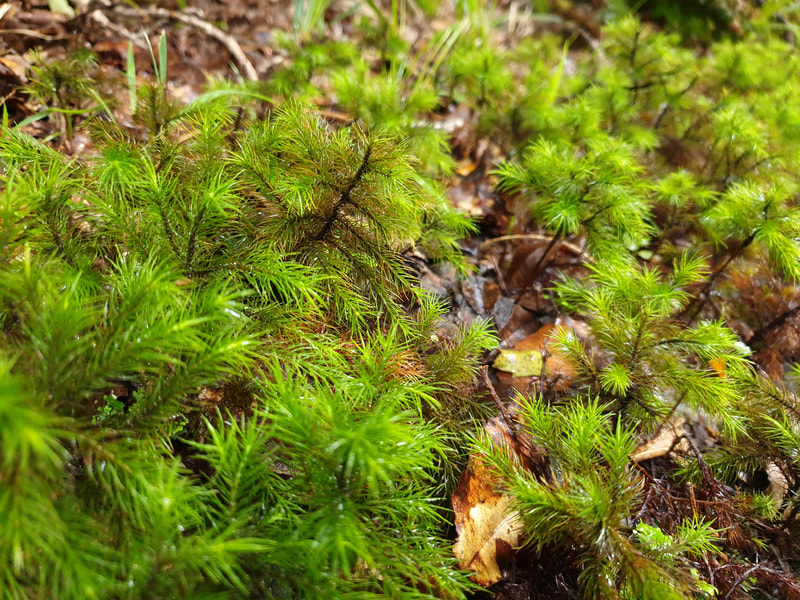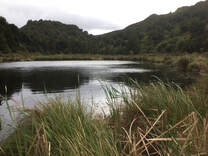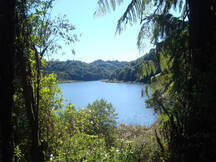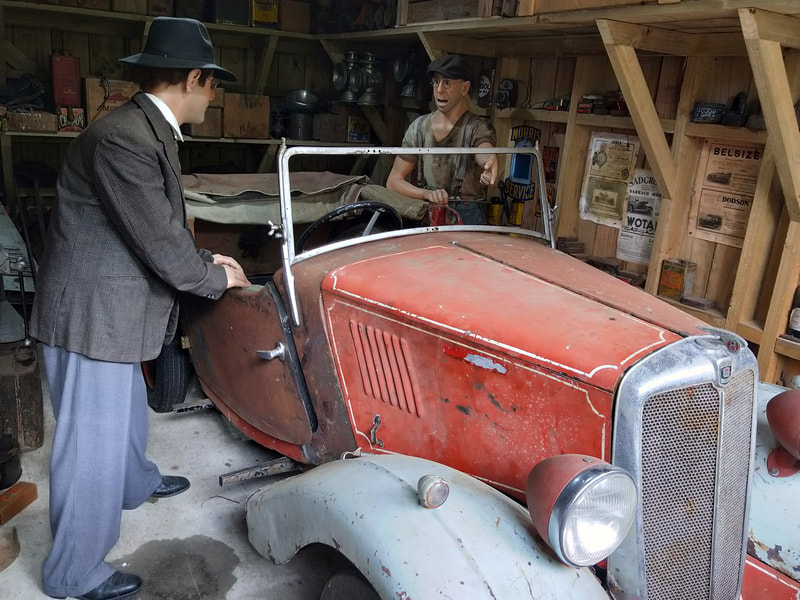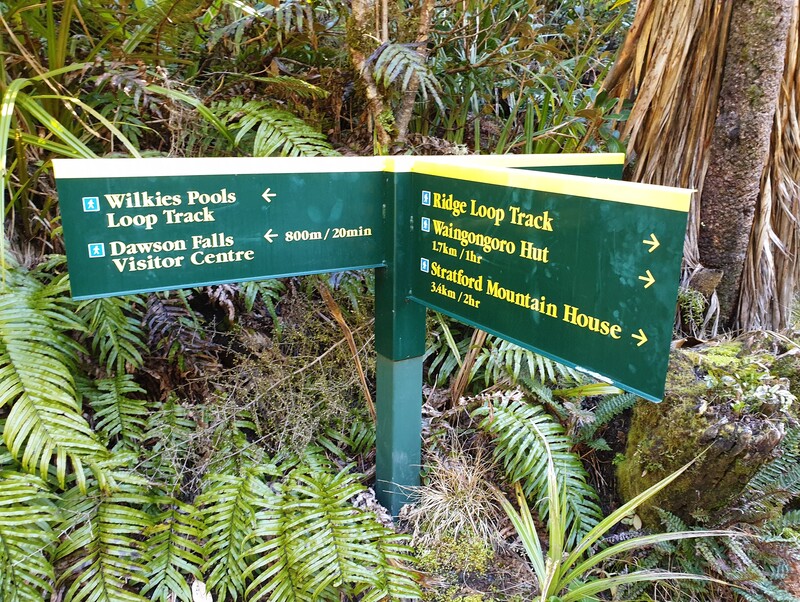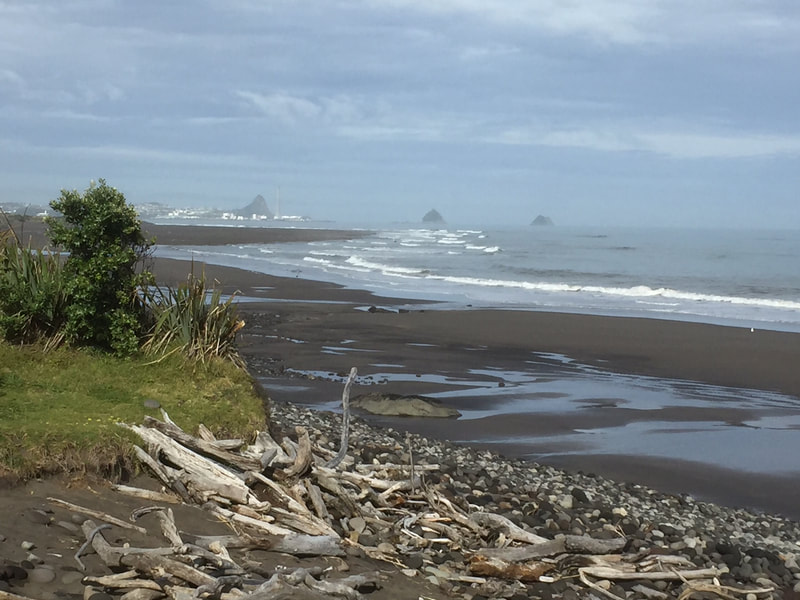NEW PLYMOUTH: 17-21 OCTOBER 2020
After a frustrating and disrupted autumn and winter due to Covid-19 restrictions, everyone was ready for some days away in fresh surroundings with good company and some new walks. Thirty five club members filled the bus and we were off!
DAY ONE: A travelling day, south to New Plymouth, with a couple of interesting stops along the way.

MANGAKARA NATURE WALK, Pirongia
A special family-friendly DOC track at the end of Grey Rd in Pirongia Forest Park with an information/visitors’ shelter area, great carpark and picnic facilities. Numbered posts along with a factsheet and illustrated signs make this a very worthwhile one hour walk. There are some giant trees here – kahikatea, pukatea, rimu – and masses of supplejack which is not to be argued with.
From the information panels trackside we learnt a new word, “senescent” (dying or in decline) relating to fallen trees.
THE THREE SISTERS (Tongaporutu)
 The Three Sisters (actually two)
The Three Sisters (actually two)
As the tide was too high to walk along the beach towards The Three Sisters sea stacks, we had to be content with enjoying the view from the clifftops at the end of Pilot Rd just off SH3. The sea air was refreshing and views great. It was pointed out that there are only “two sisters” now due to erosion and the elephant rock has lost its trunk!
DAY TWO: Pukeiti and North Egmont, Mt Taranaki
PUKEITI

One of Taranaki’s best known attractions and world-renowned for its collection of rhododendrons in a rainforest and mountain setting, Pukeiti is a pretty special place. The dream of William Douglas Cook of Eastwoodhill Arboretum (Gisborne), Pukeiti’s story began back in 1951.
Our one hour guided tour with one of the gardeners was an inspiring and enjoyable way to learn a lot in a short time, not just about rhododendrons but about many other native and exotic plants and trees.
Who knew that rhododendrons were among the earliest flowering plants on Earth and date back some 10 million years?
Who knew that rhododendrons were among the earliest flowering plants on Earth and date back some 10 million years?
It would not be difficult to spend all day here wandering the garden and rainforest paths, the Valley of the Giants and beyond.
NORTH EGMONT - MT TARANAKI
Quick facts:
Cloudy, misty and typically cool conditions on the mountain this afternoon. We had planned to walk part of the Veronica Loop Track further up the mountain but sadly there were no views to be had so we went to Plan B, the Connett Walk, Nature Walk and a look at the historic camphouse, Ambury Monument and then some time at the excellent Visitor Centre.
- Summit 2518m
- A dormant volcano which last erupted around 265 years ago
- Originally named Mt Egmont by Captain Cook
Cloudy, misty and typically cool conditions on the mountain this afternoon. We had planned to walk part of the Veronica Loop Track further up the mountain but sadly there were no views to be had so we went to Plan B, the Connett Walk, Nature Walk and a look at the historic camphouse, Ambury Monument and then some time at the excellent Visitor Centre.
 Photo taken on the day we recced the track.
Photo taken on the day we recced the track.
CONNETT LOOP WALK
At 940m up Mt Taranaki, we were in the midst of the “goblin” forest we all wanted to see – twisted and gnarly kamahi, mountain totara and tree fuschia all dripping with mosses and cloaked in lichen and filmy ferns – and it didn’t disappoint.
Technically known as montane or cloud forest (at this altitude and with the abundant rainfall), we much prefer the popular name “goblin forest” as it wasn’t hard to imagine magical creatures lurking amongst the trees!
The Connett Walk is a lovely 40-60 minute track starting just below the Visitor Centre carpark. Along the track were displayed examples of the many and various types of possum, stoat and rat traps used in the National Park (not set for obvious reasons).
 Ambury Monument
Ambury Monument
NATURE WALK, AMBURY MONUMENT & HISTORIC CAMPHOUSE
The red camphouse (1855) with its interesting history is the oldest building in a New Zealand national park. Built from handmade corrugated iron, it was originally military barracks on Marsland Hill in New Plymouth during the New Zealand land wars. Rifle firing slots are still visible in the walls, and it is now used as backpacker accommodation.
Ambury Monument is a sobering reminder of how deadly the mountain can be. Arthur Ambury died on the mountain in an attempt to arrest the fall of a fellow climber back in 1918. An information panel reminds us that over 80 people have died on Mt Taranaki since records began, and of the need to be well equipped, watch the weather conditions and to “Respect the Mountain”.
The North Egmont Visitor Centre has wonderful displays of the mountain’s geology, flora and fauna, as well as audiovisuals, a café and excellent gift shop. Our group contributed to the local economy in the gift shop (spot the Wildkiwi bandanas on our next club walk!)
DAY THREE : Lake Rotokare, Tawhiti Museum and Pukekura Park
|

This was a walk not to be rushed and it was when we stopped and stood quietly listening and watching that several saddlebacks, robins and even the rare stitchbird (hihi) showed themselves. We also heard shining cuckoos, grey warblers, tui and fantails, at times it was like an orchestra!
The reserve is a kiwi success story too – 250 kiwi are being monitored here. A rare treat was to see native banded kokopu (adult whitebait) up close in one of the tiny streams we crossed.
There was a welcome opportunity to support the Rotokare Scenic Reserve conservation efforts by purchasing honey collected from hives within the sanctuary. www.beesandtrees.com
TAWHITI MUSEUM & TRADERS AND WHALERS, HAWERA
 The man in the cafe
The man in the cafe
What a marvellous museum, widely acclaimed as one of the most innovative in New Zealand. Created by Nigel Ogle and housed in an old cheese factory, the museum is a maze of super-realistic displays, scale models, life-size figures and dioramas depicting various chapters in Taranaki’s history.
The attention to detail throughout was stunning – figures, landscapes and buildings all telling a fascinating story and bringing history to life. There were bush and coastal scenes with unbelievably convincing toetoe, tree ferns, kauri and flax. How many of us were fooled by the figure sitting at the corner table in Mrs Badger’s Café – “We can’t sit there, the table’s taken!”
The attention to detail throughout was stunning – figures, landscapes and buildings all telling a fascinating story and bringing history to life. There were bush and coastal scenes with unbelievably convincing toetoe, tree ferns, kauri and flax. How many of us were fooled by the figure sitting at the corner table in Mrs Badger’s Café – “We can’t sit there, the table’s taken!”
The most recently opened part of the complex, the Traders and Whalers, took some of us on a boat journey back to the 1820s. “Need to come back here some day”
PUKEKURA PARK
No visit to New Plymouth is complete without spending time in Pukekura Park, along bush paths, around the lakes and through the underground tunnels leading to the beautiful fernery and display houses.
There are 100 varieties of native ferns and a myriad of colourful flowering and foliage plants including exotic orchids in five connecting houses.
Opened back in 1876, the park has many unique, historical features – the Tea House (1931) with its ancient wisteria, the band rotunda (1887), the fountain (1954) and the red-painted Poet’s Bridge on the Main Lake.
Our route around the park included these features plus a 120 year old Moreton Bay fig, one of the tallest in New Zealand, and the puzzling sight of cormorants nesting in a kowhai tree at the edge of Fountain Lake.

Each summer the park is the backdrop for the Festival of Lights, where the lakes, paths, waterfall and trees are transformed into a wonderland of colour and music.
Each summer the park is the backdrop for the Festival of Lights, where the lakes, paths, waterfall and trees are transformed into a wonderland of colour and music.
DAY FOUR – Dawson Falls, Mt Taranaki and Time Around Town

WILKIES POOLS WALK
Crisp air and mist greeted us at the end of the narrow, winding mountain road up to Dawson Falls. There are a number of short walks starting at the Visitor Centre and we had chosen Wilkies Pools Loop Walk as it was flexible for our A and B walkers, 1.9km and 1.25 hr timewise to do the whole walk.
Some went up just as far as the Kapuni Stream bridge then returned, some went a little further then turned back and everyone else completed the loop, rock-hopping the stream lower down. The first part of this walk is on a very easy surface and extremely accessible, the rest not so much, a little more rocky and rugged.

We enjoyed the amazing diversity of plants, more goblin forest, ferns, mosses, mountain cabbage trees, and also the small waterfalls and rushing streams. Where the lacy goblin mosses (Weymouthia) were hanging in reach we could touch them gently and realise that they are so light and delicate you can’t feel them on your hand at all.
The clouds came and went and we were grateful to have good glimpses of the mountain now and then.
A cheeky tomtit entertained us on our return, chirping and flitting close by.
AROUND TOWN – NEW PLYMOUTH
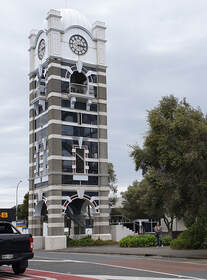
Decisions, decisions. Two hours of bus parking in the CBD meant we had two hours of free time to explore and several options: Puke Ariki Museum, the Govett-Brewster Art Gallery, Richmond Cottage and Len Lye Centre, New Plymouth’s iconic clock tower, the Wind Wand kinetic structure, and the coastal walkway. All within two city blocks and with a street map so no way to get lost!
A few found a good pub too even though it wasn’t marked on the map!
The polished steel façade of the Len Lye Centre, with its distorting reflections, intrigued the photographers, as did some of the sculpture on the coastal walkway.
DAY FIVE - Te Rewa Rewa Bridge, Coastal Walkway, then home
TE REWA REWA BRIDGE & COASTAL WALKWAY

As we left New Plymouth on our final day we visited this impressive structure across the Waiwhakaiho River, and were incredibly lucky to have a clear view of Mt Taranaki through the bridge, a photographer’s gift.
After lots of pics were taken we walked east following the 13km walkway towards Bell Block and exited partway along at Waipu Lagoons. This part of the route was along the coast with views back to Port Taranaki, the Sugar Loaves, Paritutu Rock and the lonely power station chimney, but also through farmland with friendly cows, quite different to the city end of the route.
Then it was time to head north towards home, stopping briefly at Mokau (for whitebait!) and Pirongia (for food and coffee and to stretch our legs once more).
If anyone is wondering, we also enjoyed some lovely meals - Cafe 487 at Mimi, Italian food at Area 41, meatballs at Polpetta and a welcome roast at Cobb & Co.
With thanks to our organizers, Molly, Sharleen, Fiona and Anne, to Okie (our driver) and those members who helped in other ways.
Text: Sharleen
Photos: Sharleen, Frankie, Cheryl
If anyone is wondering, we also enjoyed some lovely meals - Cafe 487 at Mimi, Italian food at Area 41, meatballs at Polpetta and a welcome roast at Cobb & Co.
With thanks to our organizers, Molly, Sharleen, Fiona and Anne, to Okie (our driver) and those members who helped in other ways.
Text: Sharleen
Photos: Sharleen, Frankie, Cheryl





